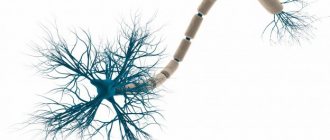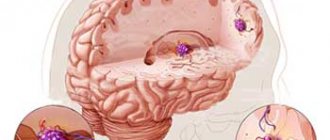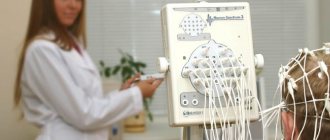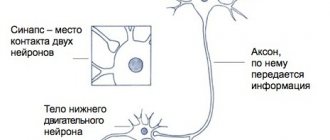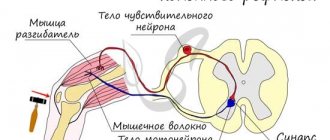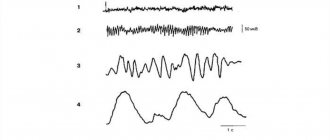| This article includes a list of references, related materials or external links. but its sources remain unclear as it lacks embedded quotations . |
| Alpha motor neuron | |
| Alpha motor neurons originate from the basal lamina (basal plate) of the developing embryo. | |
| Identifiers | |
| NeuroLex ID | sao1154704263 |
| H2.00.01.0.00008 | |
| F.M.A. | 83664 |
| Anatomical terms of neuroanatomy [edit in Wikidata] | |
Alpha
(
α
)
motor neurons
(also called
alpha motor neurons
), large, multipolar lower motor neurons of the brainstem and spinal cord. They innervate the extrafusal muscle fibers of skeletal muscles and are directly responsible for initiating their contraction. Alpha motor neurons are different from gamma motor neurons, which innervate the intrafusal muscle fibers of the muscle spindles.
Although their cell bodies are found in the central nervous system (CNS), α-motoneurons are also considered part of the somatic nervous system, a branch of the peripheral nervous system (PNS), because their axons extend peripherally to innervate skeletal muscles. .
The alpha motor neuron and the muscle fibers it innervates are a motor unit. Motor neuron pool
contains the cell bodies of all motor neurons involved in the alpha contracting muscle.
Location[edit]
Alpha motor neurons (α-MNs), innervating the head and neck, are found in the brainstem; the remaining α-MNs innervate the rest of the body and are found in the spinal cord. There are more α-MNs in the spinal cord than in the brainstem because the amount of α-MNs is directly proportional to the degree of fine motor control in that muscle. For example, muscles of one finger have more α-MN per fiber and more α-MN overall than muscles of the quadriceps, allowing more precise control of the force exerted by the finger.
Typically, alpha MNs on one side of the brainstem or spinal cord innervate muscles on the same side of the body. An exception is the trochlear nucleus in the brainstem, which innervates the superior oblique muscle of the eye on the opposite side of the face.
Brain stem[edit]
In the brainstem, α-MNs and other neurons are located in clusters of cells called nuclei
, some of which contain cell bodies of neurons belonging to cranial nerves.
Not all cranial nerve nuclei contain α-MNs; those that are present are motor nuclei
, and others are
sensory nuclei
. The motor nuclei are found throughout the brainstem—the medulla, pons, and midbrain—and for developmental reasons are located near the midline of the brain.
Typically, motor nuclei located higher in the brainstem (i.e., more rostral) innervate muscles located higher on the face. For example, the oculomotor nucleus contains α-MNs that innervate the eye muscles and is located in the midbrain, the most rostral component of the brainstem. In contrast, the hypoglossal nucleus, which contains α-MNs that innervate the tongue, is located in the medulla most caudal (i.e., inferior) to the brainstem structures.
Spinal cord[edit]
The corticospinal tract is one of the major descending pathways from the brain to the alpha MNBU of the spinal cord.
In the spinal cord, α-MNs are located in the gray matter, forming the ventral horn. These α-MNs provide the motor component of the spinal nerves that innervate the muscles of the body.
Alpha motor neurons are located in lamina IX according to the Rexed plate system.
As in the brainstem, higher segments of the spinal cord contain α-MNs that innervate muscles higher up on the body. For example, the biceps brachii, a muscle of the arm, is innervated by α-MNs in spinal cord segments C5, C6, and C7, which lie rostral to the spinal cord. On the other hand, the gastrocnemius muscle, one of the leg muscles, is innervated by α-MNs in segments S1 and S2, which are located caudally in the spinal cord.
Alpha motor neurons are located in a specific region of the gray matter of the spinal cord. This region is designated lamina IX in the Rexed lamina system, which classifies gray matter regions based on their cytoarchitecture. Lamina IX is located predominantly in the medial portion of the ventral horn, although there is some contribution to lamina IX from a recruitment of motor neurons located more laterally. As in other areas of the spinal cord, the cells of this plate are somatotropic organized, meaning that the position of neurons in the spinal cord is related to which muscles they innervate. Specifically, α-MNs in the medial zone of lamina IX tend to innervate proximal muscles of the body, whereas those in the lateral zone tend to innervate more distal muscles. A similar somatotopy is associated with α-MNs that innervate the flexor and extensor muscles: α-MNs that innervate the flexors are usually located in the dorsal part of lamina IX; those innervating the extensors are usually located more ventrally.
An excerpt characterizing the Alpha Motor Neuron
He constantly and painfully insulted Princess Marya, but the daughter did not even make an effort to forgive him. How could he be guilty before her, and how could her father, who, she still knew, loved her, be unjust? And what is justice? The princess never thought about this proud word: “justice.” All the complex laws of humanity were concentrated for her in one simple and clear law - the law of love and self-sacrifice, taught to us by the One who lovingly suffered for humanity, when he himself is God. What did she care about the justice or injustice of other people? She had to suffer and love herself, and that’s what she did. In winter, Prince Andrei came to Bald Mountains, he was cheerful, meek and gentle, as Princess Marya had not seen him for a long time. She had a presentiment that something had happened to him, but he did not say anything to Princess Marya about his love. Before leaving, Prince Andrei talked for a long time about something with his father, and Princess Marya noticed that before leaving, both were dissatisfied with each other. Soon after the departure of Prince Andrei, Princess Marya wrote from Bald Mountains to St. Petersburg to her friend Julie Karagina, whom Princess Marya dreamed of, as girls always dream, of marrying her brother, and who at that time was in mourning on the occasion of the death of her brother, killed in Turkey. “Sorrow, apparently, is our common destiny, dear and gentle friend Julieie.” “Your loss is so terrible that I cannot otherwise explain it to myself, as a special mercy of God, who wants to experience - by loving you - you and your excellent mother. Ah, my friend, religion, and only religion, can, let alone console us, but save us from despair; one religion can explain to us what a person cannot understand without its help: why, why beings who are kind, sublime, who know how to find happiness in life, who not only do not harm anyone, but are necessary for the happiness of others - are called to God, but remain to live evil, useless, harmful, or those who are a burden to themselves and others. The first death that I saw and which I will never forget - the death of my dear daughter-in-law, made such an impression on me. Just as you ask fate why your beautiful brother had to die, in the same way I asked why this angel Liza had to die, who not only did not do any harm to a person, but never had anything but good thoughts in her soul . And well, my friend, five years have passed since then, and I, with my insignificant mind, am already beginning to clearly understand why she needed to die, and how this death was only an expression of the infinite goodness of the Creator, all of whose actions , although we mostly do not understand them, they are only manifestations of His infinite love for His creation. Perhaps, I often think, she was too angelically innocent to have the strength to bear all the responsibilities of a mother. She was impeccable, like a young wife; perhaps she could not be such a mother. Now, not only did she leave us, and especially Prince Andrei, the purest regret and memory, she will probably get that place there that I do not dare hope for for myself. But, not to mention her alone, this early and terrible death had the most beneficial effect, despite all the sadness, on me and on my brother. Then, in a moment of loss, these thoughts could not come to me; Then I would have driven them away with horror, but now it is so clear and undeniable. I am writing all this to you, my friend, only to convince you of the gospel truth, which has become a life rule for me: not a single hair of my head will fall without His will. And His will is guided only by boundless love for us, and therefore everything that happens to us is all for our good. Are you asking if we will spend next winter in Moscow? Despite all my desire to see you, I don’t think and don’t want it. And you will be surprised that Buonaparte is the reason for this. And here's why: my father's health is noticeably weakening: he cannot tolerate contradictions and becomes irritable. This irritability, as you know, is directed primarily at political matters. He cannot bear the thought that Buonaparte is dealing as with equals, with all the sovereigns of Europe and especially with ours, the grandson of the Great Catherine! As you know, I am completely indifferent to political affairs, but from the words of my father and his conversations with Mikhail Ivanovich, I know everything that is happening in the world, and especially all the honors given to Buonaparte, who, it seems, is still only in Lysykh Mountains throughout the globe are not recognized as either a great man, much less a French emperor. And my father can't stand it. It seems to me that my father, mainly due to his view of political affairs and foreseeing the clashes that he will have, due to his manner of expressing his opinions without embarrassment with anyone, is reluctant to talk about a trip to Moscow. Whatever he gains from treatment, he will lose due to the disputes about Buonaparte, which are inevitable. In any case, this will be decided very soon. Our family life continues as before, with the exception of the presence of brother Andrei. He, as I already wrote to you, has changed a lot lately. After his grief, only this year has he completely morally come to life. He became the same as I knew him as a child: kind, gentle, with that golden heart that I know no equal to. He realized, it seems to me, that life is not over for him. But along with this moral change, he physically became very weak. He became thinner than before, more nervous. I am afraid for him and am glad that he took this trip abroad, which doctors have long prescribed for him. I hope this fixes it. You write to me that in St. Petersburg they talk about him as one of the most active, educated and intelligent young people. Sorry for the pride of kinship - I never doubted it. It is impossible to count the good that he did here to everyone, from his peasants to the nobles. Arriving in St. Petersburg, he took only what he should have. I’m surprised how rumors from St. Petersburg reach Moscow in general, and especially such incorrect ones as the one you are writing to me about - the rumor about the imaginary marriage of my brother to little Rostova. I don’t think Andrei will ever marry anyone, and especially not her. And here’s why: firstly, I know that although he rarely talks about his late wife, the sadness of this loss is too deeply rooted in his heart for him to ever decide to give her a successor and stepmother to our little angel. Secondly, because, as far as I know, this girl is not the type of woman that Prince Andrei might like. I don’t think that Prince Andrey would choose her as his wife, and I’ll say frankly: I don’t want this. But I started chatting, I’m finishing my second piece of paper. Farewell, my dear friend; May God keep you under His holy and mighty protection. My dear friend, Mademoiselle Bourienne, kisses you. Marie." In the middle of summer, Princess Marya received an unexpected letter from Prince Andrei from Switzerland, in which he told her strange and unexpected news. Prince Andrei announced his engagement to Rostova. His entire letter breathed with loving enthusiasm for his bride and tender friendship and trust in his sister. He wrote that he had never loved as much as he loves now, and that now he only understood and got to know life; he asked his sister to forgive him for the fact that on his visit to Bald Mountains he did not tell her anything about this decision, although he spoke about it with his father. He did not tell her this because Princess Marya would have asked her father to give his consent, and having not achieved her goal, she would have irritated her father and would have borne the brunt of his displeasure on herself. However, he wrote, then the matter was not as finally decided as it is now. “Then my father appointed me a period, a year, and now six months have passed, half of the appointed period has passed, and I remain more firm than ever in my decision. If the doctors had not kept me here, at the waters, I would have been in Russia myself, but now I must postpone my return for another three months. You know me and my relationship with my father. I don’t need anything from him, I was and will always be independent, but to do something contrary to his will, to earn his anger, when he might not have long to be with us, would destroy half of my happiness. I am now writing him a letter about the same thing and asking you, taking a good moment, to give him the letter and notify me of how he views all this and whether there is any hope that he will agree to reduce the term by three months.” After much hesitation, doubt and prayer, Princess Marya handed the letter to her father. The next day, the old prince said to her calmly: “Write to your brother to wait until I die... Not for long - I’ll untie you soon... The princess wanted to object something, but her father did not allow her, and began to raise his voice more and more. - Get married, get married, my dear... Good relationship!... Smart people, huh? Rich, huh? Yes. Nikolushka will be a good stepmother! Write to him and let him get married tomorrow. Nikolushka’s stepmother will be her, and I’ll marry Burienka!... Ha, ha, ha, and he won’t be without a stepmother! Only one thing, I don’t need any more women in my house; Let him get married and live on his own. Maybe you will move in with him too? - he turned to Princess Marya: - with God, in the frost, in the frost... in the frost!... After this outbreak, the prince never spoke about this matter again. But restrained annoyance at his son’s cowardice was expressed in the father’s relationship with his daughter. To the previous pretexts for ridicule, a new one was added - talk about the stepmother and courtesy to m lle Bourienne. - Why shouldn’t I marry her? - he said to his daughter. - She will be a glorious princess! “And lately, to her bewilderment and surprise, Princess Marya began to notice that her father was really beginning to bring the Frenchwoman closer and closer to him. Princess Marya wrote to Prince Andrei about how his father accepted his letter; but she consoled her brother, giving hope of reconciling her father with this thought. Nikolushka and his upbringing, Andre and religion were the consolations and joys of Princess Marya; but in addition, since every person needs his own personal hopes, Princess Marya had in the deepest secret of her soul a hidden dream and hope, which gave her the main consolation in her life. This comforting dream and hope was given to her by God's people - holy fools and wanderers, who visited her secretly from the prince. The more Princess Marya lived, the more she experienced life and observed it, the more she was surprised by the short-sightedness of people seeking pleasure and happiness here on earth; workers, suffering, fighting and doing evil to each other, to achieve this impossible, illusory and vicious happiness. “Prince Andrei loved his wife, she died, this is not enough for him, he wants to connect his happiness with another woman. The father does not want this because he wants a more noble and rich marriage for Andrei. And they all fight and suffer, and torment, and spoil their soul, their eternal soul, in order to achieve benefits for which the term is an instant. Not only do we ourselves know this, but Christ, the Son of God, came down to earth and told us that this life is an instant life, a test, and we still hold on to it and think of finding happiness in it. How did no one understand this? - thought Princess Marya. No one except these despicable people of God who, with bags on their shoulders, come to me from the back porch, afraid of catching the prince’s eye, and not so as not to suffer from him, but so as not to lead him into sin. Leave family, homeland, all worries about worldly goods in order to, without clinging to anything, walk in rags, under someone else’s name from place to place, without harming people, and praying for them, praying for those who persecute , and for those who patronize: there is no truth and life higher than this truth and life!” There was one wanderer, Fedosyushka, a 50-year-old, small, quiet, pockmarked woman who had been walking barefoot and wearing chains for more than 30 years. Princess Marya especially loved her. One day, when in a dark room, by the light of one lamp, Fedosyushka was talking about her life, the thought suddenly came to Princess Marya with such force that Fedosyushka alone had found the right path of life, that she decided to go wandering herself. When Fedosyushka went to bed, Princess Marya thought about it for a long time and finally decided that, strange as it was, she had to go wandering. She confided her intention to only one confessor, the monk, Father Akinfiy, and the confessor approved her intention. Under the pretext of a gift to the pilgrims, Princess Marya stocked up for herself the complete wanderer's attire: a shirt, bast shoes, a caftan and a black scarf. Often approaching the treasured chest of drawers, Princess Marya stopped in indecision about whether the time had already come to carry out her intentions. Often listening to the stories of the wanderers, she was excited by their simple, mechanical speeches for them, but full of deep meaning for her, so that several times she was ready to drop everything and run away from home. In her imagination, she already saw herself with Fedosyushka in rough rags, walking with a stick and a wallet along a dusty road, directing her journey without envy, without human love, without desires from saint to saint, and in the end, to where there is no sadness , not a sigh, but eternal joy and bliss. “I will come to one place and pray; If I don’t have time to get used to it and fall in love with it, I’ll move on. And I will walk until my legs give way, and I will lie down and die somewhere, and I will finally come to that eternal, quiet haven, where there is no sadness or sighing!...” thought Princess Marya. But then, seeing her father and especially little Coco, she weakened in her intention, slowly cried and felt that she was a sinner: she loved her father and nephew more than God. Biblical tradition says that the absence of work - idleness was a condition for the bliss of the first man before his fall. The love for idleness remained the same in fallen man, but the curse still weighs on man, and not only because we must earn our bread by the sweat of our brow, but because, due to our moral properties, we cannot be idle and calm. A secret voice says that we must be guilty of being idle. If a person could find a state in which, being idle, he would feel useful and fulfilling his duty, he would find one side of primitive bliss. And this state of obligatory and impeccable idleness is enjoyed by a whole class - the military class. This obligatory and impeccable idleness was and will be the main attraction of military service. Nikolai Rostov fully experienced this bliss, after 1807 he continued to serve in the Pavlograd regiment, in which he already commanded a squadron received from Denisov. Rostov became a hardened, kind fellow, whom Moscow acquaintances would have found somewhat mauvais genre [bad taste], but who was loved and respected by his comrades, subordinates and superiors, and who was satisfied with his life. Lately, in 1809, he more often found his mother complaining in letters from home that things were getting worse and worse, and that it was time for him to come home, please and reassure his old parents. Reading these letters, Nikolai felt fear that they wanted to take him out of the environment in which, having protected himself from all everyday confusion, he lived so quietly and calmly. He felt that sooner or later he would have to again enter that whirlpool of life with frustrations and adjustments in affairs, with managers’ accounts, quarrels, intrigues, with connections, with society, with Sonya’s love and a promise to her. All this was terribly difficult, confusing, and he answered his mother’s letters with cold, classic letters that began: Ma chere maman [My dear mother] and ended: votre obeissant fils, [Your obedient son,] keeping silent about when he intended to come . In 1810, he received letters from his relatives, in which he was informed about Natasha’s engagement to Bolkonsky and that the wedding would take place in a year, because the old prince did not agree. This letter upset and insulted Nikolai. Firstly, he was sorry to lose Natasha from home, whom he loved more than anyone in the family; secondly, from his hussar point of view, he regretted that he was not there, because he would have shown this Bolkonsky that it was not such a great honor to be related to him and that if he loved Natasha, he could do without permission from an extravagant father. For a minute he hesitated whether to ask for leave to see Natasha as a bride, but then the maneuvers came up, thoughts about Sonya, about the confusion came, and Nikolai put it off again. But in the spring of that year he received a letter from his mother, who wrote secretly from the count, and this letter convinced him to go. She wrote that if Nikolai did not come and get down to business, then the entire estate would go under the hammer and everyone would go around the world. The Count is so weak, he has trusted Mitenka so much, and is so kind, and everyone is deceiving him so much that everything goes worse and worse. “For God’s sake, I beg you, come now, if you do not want to make me and your whole family unhappy,” the countess wrote.
Development[edit]
Under the influence of the sonic hedgehog protein, shown here, cells in the lower lamina of the developing spinal cord differentiate into alpha motor neurons.
Alpha motor neurons originate in the basal lamina, the ventral part of the neural tube of the developing embryo. Sonic hedgehog (Shh) is secreted by the adjacent notochord and other ventral structures (such as the floor plate), creating a gradient of highly concentrated Shh in the basal plate and less concentrated Shh in the alar plate. Under the influence of Shh and other factors, some basal lamina neurons differentiate into α-MNs.
Like other neurons, α-MNs send axon projections to reach their target extrafusal muscle fibers through axon guidance, a process regulated in part by neurotrophic factors released by the target muscle fibers. Neurotrophic factors also ensure that each muscle fiber is innervated by the appropriate number of α-MNs. Like most types of neurons in the nervous system, α-MNs are more abundant early in development than in adulthood. Muscle fibers secrete a limited number of neurotrophic factors that can support only a portion of the α-MNs that are initially projected into the muscle fibers. Those α-MNs that do not receive enough neurotrophic factors will undergo apoptosis, a form of programmed cell death.
Because they innervate many muscles, some α-MN clusters receive high concentrations of neurotrophic factors and survive this stage of neuronal pruning. This is true for α-MNs innervating the upper and lower limbs: these α-MNs form large columns of cells that contribute to cervical and lumbar spinal cord enlargement. In addition to receiving neurotrophic factors from muscle, α-MNs also secrete a number of trophic factors to support the muscle fibers they innervate. Reduced levels of trophic factors contribute to the muscle atrophy that follows α-MN damage.
Communication [edit]
Like other neurons, lower motor neurons have both afferent (incoming) and efferent (outgoing) connections. Alpha motor neurons receive input from a number of sources, including upper motor neurons, sensory neurons, and interneurons. The main output of α-MN is extrafusion muscle fibers. This afferent and efferent connection is necessary to achieve coordinated muscle activity.
Afferent input[edit]
Selected pathways between upper motor neurons and alpha motor neurons
| UMN origin | α-MN target | Path name |
| Cortex | Brain stem | Corticonuclear tract |
| Cortex | Spinal cord | Corticospinal tract |
| Red core | Spinal cord | Rubrospinal tract |
| Vestibular nuclei | Spinal cord | Vestibulospinal tract |
| Midbrain tectum | Spinal cord | Tectospinal tract |
| Reticular formation | Spinal cord | Reticulospinal tract |
Upper motor neurons (UMN) send inputs to the α-MN through several pathways, including (but not limited to) the corticonuclear, corticospinal, and rubrospinal tracts. The corticonuclear and corticospinal tracts are commonly encountered in studies of the interaction of upper and lower motor neurons in the control of voluntary movements.
The corticonuclear tract is so named because it connects the cerebral cortex to the cranial nerve nuclei. (The corticonuclear tract is also called the corticobulbar tract
, since the target in the brainstem—the medulla oblongata—is archaically called the “bulb.”) It is along this pathway that upper motor neurons descend from the cortex and synapse on α-MNs. brain stem. Similarly, the cortical UMNs directly control spinal cord α-MNs via the lateral and ventral corticospinal tracts.
Sensory input to α-MNs is extensive and originates from Golgi tendon organs, muscle spindles, mechanoreceptors, thermoreceptors, and other sensory neurons in the periphery. These connections provide the structure of the neural circuits underlying reflexes. There are several types of reflex circuits, the simplest of which consists of a single synapse between a sensory neuron and an α-MN. The knee jerk reflex is an example of such a monosynaptic reflex.
The most extensive input to α-MNs comes from local interneurons, which are the most abundant type of neuron in the spinal cord. Among their many functions is the synapse of interneurons onto α-MNs to create more complex reflex circuits. One type of interneuron is the Renshaw cell.
Efferent output[edit]
Alpha motor neurons send fibers, which mostly synapse, onto extrafusion muscle fibers. Other fibers from the α-MN synapse on Renshaw cells, that is, inhibitory interneurons, which synapse with α-MN and limit its activity to prevent muscle damage.
Using patient motor neurons as a treatment for amyotrophic lateral sclerosis
Amyotrophic lateral sclerosis (ALS) is a severe, fatal neurodegenerative disease that results in the death of motor neurons and voluntary muscle activity. Although studies in animal models (mouse) have identified potential treatments, they have not been found to be significantly effective in human trials. Researchers at Boston Children's Hospital collaborating with Pfizer report the discovery of a highly effective drug target using motor neurons obtained from ALS patients. Thanks to this platform, it was possible to confirm the target (theoretically known previously) and identify a class of drugs - dopamine D2 receptor agonists - as potential new therapies.
This high-throughput screening system is designed to identify compounds that reduce motor neuron hyperexcitability, a hallmark of ALS. Motor neurons obtained from ALS patients are cultured in 384-well plates, and after 3-4 weeks, compounds from small molecule chemical libraries against already known molecular targets are added. In vivo GCaMP imaging to detect calcium waves indicative of neuronal firing is performed at 6 and 24 hours to determine excitability. Compounds identified through initial screening subsequently undergo confirmatory screening and efficacy and toxicity testing.
Researchers led by Clifford Wulff, M.D., director of the Kirby Center for Neuroscience at Children's Hospital Boston, and first authors Xuan Huang, Ph.D., and Kasper Root, Ph.D., from the Wulff laboratory described the platform and their findings in Cell Reports magazine, June 8.
To create motor neurons to detect the effectiveness of drugs, the team used stimulated pluripotent stem cells obtained in Kevin Eggan's laboratory at Harvard University from tissue samples from ALS patients carrying the SOD1 (A4V) mutation. Wulff's lab has also developed highly sensitive live-cell imaging technology to measure motor neuron hyperexcitability, called hyperexcitability. Tendencies to become overly "excited" before and after exposure to potential drugs. Previously, Wolf et al. have already demonstrated that human motor neurons with mutations characteristic of ALS are more excitable than normal motor neurons.
According to Wolfe, this hyperexcitability makes motor neurons more susceptible to degeneration, which ultimately leads to their death. This imaging platform allows rapid assessment of hyperactivity in 384-well motor neuron plates and testing of cell response to a wide variety of drugs.
The technology, called GCaMP imaging, has not previously been widely used in diagnostics or experiments on ALS. GCaMP is an indicator of calcium levels in neurons, signaling through fluorescence how often action potentials are generated in neurons.
In total, the researchers tested about 2,900 Pfizer drugs with well-known mechanisms of action. After three stages of screening, they found 67 compounds that did not have toxic effects and were able to reduce the hyperexcitability of motor neurons.
The dots in the graph on the left show the average effects of different compounds on motor neuron excitability at 6 and 24 h. Red dots indicate compounds that increase excitability; blue dots indicate compounds that reduce excitability; green dots are chemical compounds whose effects have not been demonstrated. Several orange dots (top left) indicate conflicting results at 6 and 24 hours. The pie chart on the right quantifies the results after the initial screening.
By conducting a screen that looked for an altered motor neuron phenotype in ALS, namely hyperexcitability, the authors were able to discover new targets and disease mechanisms, as well as confirm previously existing theories, Wolf said.
Further experiments focused on 13 potential drug targets with the greatest effect, seven of which belonged to two classes (AMPA receptors and Kv7 potassium channels) that were already known to be associated with motor neuron hyperexcitability in ALS. A recent clinical trial found that Kv7 channel openers reduced motor neuron hyperexcitability in ALS. QurAlis, a company co-founded by Wolfe, Eggan and Routh, is developing these drugs to treat ALS.
The present study identified a promising new class of drugs—dopamine D2 receptor (D2R) agonists. The involvement of these receptors in the formation of increased excitability of motor neurons was not previously recognized. Several D2R agonists (bromocriptine, sumanirol) are commercially available, which opens the possibility of their use in patients with ALS.
The results of the authors' study suggest that neuronal excitability is a reliable way to identify relevant targets that can be influenced by drugs. This could also be used for other neurological diseases that involve neuronal excitability, such as epilepsy and neurodegenerative diseases (such as Alzheimer's), Wolfe said.
Wolf's team is using human neuronal screening platforms to identify new targets for treating pain and neuropathy.
The scientist continues that one of the most difficult tasks in drug discovery is determining the key mechanism(s) in the pathogenesis of the disease. “Using patient-derived neurons to model disease pathways and test a wide range of chemical compounds with known pharmacological targets could be a driving force in the development of new treatments.”
Alarm[edit]
Main article: Neuromuscular junction
Like other neurons, α-MNs transmit signals in the form of action potentials, rapid changes in electrical activity that propagate from the cell body to the end of the axon. To increase the speed at which action potentials travel, α-MN axons are large in diameter and are heavily myelinated by both oligodendrocytes and Schwann cells. Oligodendrocytes myelinate the part of the α-MN axon that is in the central nervous system (CNS), while Schwann cells myelinate the part that is in the peripheral nervous system (PNS). The transition between the CNS and PNS occurs at the level of the pia mater, the innermost and thinnest layer of meningeal tissue surrounding the components of the CNS.
The α-MN axon connects to its extrafusal muscle fiber through the neuromuscular junction, a special type of chemical synapse that differs in both structure and function from the chemical synapses that connect neurons to each other. Both types of synapses rely on neurotransmitters to convert an electrical signal to a chemical signal and back again. One of their differences is that synapses between neurons typically use glutamate or GABA as neurotransmitters, while neuromuscular junctions exclusively use acetylcholine. Acetylcholine is accepted by nicotinic acetylcholine receptors. on extrafusal muscle fibers, causing them to contract.
Like other motor neurons, α-MNs are named after the properties of their axons. Alpha motor neurons have Aα axons, which are large-caliber, heavily myelinated fibers that conduct action potentials rapidly. In contrast, gamma motor neurons have Aγ axons, which are thin, lightly myelinated fibers that conduct less rapidly.
Clinical significance[edit]
Main article: Motor neuron disease
Poliomyelitis, caused by the poliovirus observed here, is associated with selective cell loss in the ventral horn of the spinal cord, where α-MNs are located.
a-MU lesion is the most common type of lower neuron motor lesion. Damage can be caused by trauma, ischemia, and infection, among other things. In addition, some diseases are associated with selective loss of α-MN. For example, polio is caused by a virus that specifically attacks motor neurons in the ventral horn of the spinal cord. Amyotropic lateral sclerosis is also associated with selective motor neuron loss.
Paralysis is one of the most pronounced consequences of α-MN damage. Because α-MNs provide the only innervation to extrafusal muscle fibers, loss of α-MN effectively severing the connection between the brainstem and spinal cord and the muscles they innervate. Without this connection, voluntary and involuntary (reflex) muscle control is impossible. Voluntary muscle control is lost because α-MNs transmit voluntary signals from upper motor neurons to muscle fibers. Loss of involuntary control results from interruption of reflex circuits, such as the tonic stretch reflex. The consequence of interruption of the reflex is a decrease in muscle tone, which leads to flaccid paresis. Another consequence is inhibition of deep tendon reflexes, causing hyporeflexia.
Muscle weakness and atrophy are also inevitable consequences of α-MN lesions. Because muscle size and strength depend on the degree of use, denervated muscles are prone to atrophy. A secondary cause of muscle atrophy is that denervated muscles are no longer supplied with trophic factors from the α-MNs that innervate them. Alpha motor neuron lesions also result in abnormal EMG potentials (such as fibrillation potentials) and fasciculations, the latter being spontaneous involuntary muscle contractions.
Diseases that impair signaling between α-MN and extrafusal muscle fibers, namely neuromuscular junction diseases, have features similar to those of α-MN disease. For example, myasthenia gravis is an autoimmune disease that interferes with signaling across the neuromuscular junction, resulting in functional denervation of the muscles.
Gamma motor neuron
Hypotonia may be caused by damage to alpha neurons or Ia afferents carrying sensory information to alpha neurons. This creates a decrease in muscle tone. In contrast, hypertension is caused by damage to the descending tracts that end in the spinal cord. It increases muscle tone by increasing the overall response of alpha motor neurons to sensory Ia input.
Spasms can be caused by a discrepancy between the activity of alpha and gamma motor neurons, i.e., too much stimulation of one or the other. The imbalance causes inaccurate readings from muscle receptors in the muscle spindle. Therefore, the sensory neurons responsible for the brain and spinal cord are misleading. For example, if a patient has overactive gamma motor neurons, there will be resistance to passive movement, causing stiffness, also called spasticity. This often occurs in people with damage to higher centers affecting the descending pathways. Sometimes this can cause the gamma shift (the constant discharge of some gamma motor neurons) to be larger or smaller than normal. In patients with excessive gamma bias, the sensory endings in the muscle spindles discharge too frequently, resulting in more muscle activity than necessary. Additionally, this hyperactivity in the spindle gamma loop can cause spasticity. [7]
Gamma motor neurons help keep the muscle spindle tight, thereby regulating sensitivity. Therefore, if gamma motor neurons do not fire properly, muscle movement may be impaired. Fine motor skills such as finger and eye movements are most affected because the lack of tension in the muscle spindle interferes with its ability to sense the degree of stretch through sensory endings. This means that the muscle will not be able to move accordingly accurately. Lesions that control the descending pathways from the lower motor neurons to the upper extremities can result in the patient losing the ability to accurately control movement.
In a clinical setting, it is possible to test whether someone has an abnormally low or high gamma gain simply by moving the patient's hand. Gamma amplification is a process in which the acceleration, speed and length of muscle changes are increased equally, allowing for more precise movements in the appropriate situation. If it is more difficult to bend the patient's arm forward and backward at the elbow, then he/she will have more gamma gain, while someone whose arm moves very easily will have less gamma gain.
Oscilloscopes can be used to measure axon action potentials from a motor neuron to assess overall muscle activity. Although it cannot distinguish alpha motor neurons from gamma motor neurons, it is useful for understanding whether one of them has abnormal motor neuron activity. When the rate of activity in the descending pathway is low, fewer and smaller motor neurons are activated, resulting in little muscle force. This will appear on the oscilloscope as lower peaks on the y-axis.
